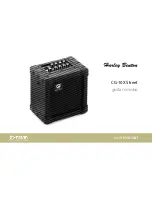
The Oakley Classic VCA
This is a voltage controlled amplifier module inspired in part by a classic vintage design. The
Oakley Classic VCA is based on the ARP4019 sub-module which was used on the wooden
case ARP2600P semi-modular synthesiser. The design has a fully discrete core but uses op-
amps for input summing and the output drivers.
Two signal inputs are provided, one DC coupled and the other AC coupled. The former
allows audio and low frequency signals to be processed. While the latter has a high pass filter
so that it can be only used to process alternating frequencies. Both inputs can be used
simultaneously and each one features an input level control.
Two control voltage (CV) inputs are provided. CV1 is linear and is provided with a standard
attenuator pot that can control the sensitivity of the input. CV2 can be operated in either
exponential or linear mode.
CV2 features a reversible attenuator. When the pot is turned right of its central position, the
pot acts as a normal attenuator; increasing the sensitivity of the CV input. Left of centre, the
pot will act in inverting mode and the CV will be tipped upside down so that increasing
positive voltages will decrease the gain of the VCA.
When no input jack is inserted into the CV1 input, the CV1 pot becomes a gain control. This
allows the pot to be used as a simple volume control but when set high it also allows CV2 to
turn the VCA off.
The 5U version of the Classic VCA has two outputs. OUT A is the standard output of the
VCA. OUT B, gives you the difference signal between the sum of the two inputs and the final
output of the VCA. This is a sort of anti-output; when the VCA output signal goes up in level
this output goes lower. You can use it as a ring modulator (with gain pot set to max) or in
conjunction with OUT A as a voltage controlled pan.
4



























